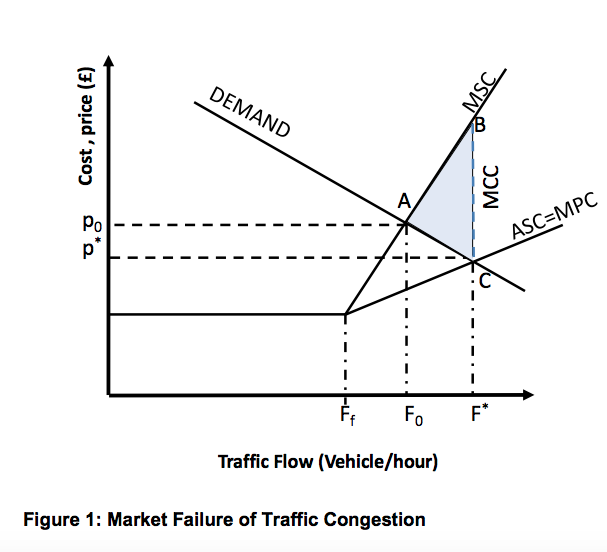Extract: How Economists evaluate Congestion
22nd September 2015
The market failure of traffic congestion is demonstrated in Figure 1, we assume identical road users using a uniform road network at a certain time of day. The horizontal axis indicates traffic flow, number of vehicles are passing through a definite length of road in an hour time (vehicles/hour), while the vertical axis specifies costs of using the road. The marginal private cost (MPC) curve is the unregulated cost of each vehicle per hour (£/vehicle/hour) in using a road i.e. fuel costs, driver and passenger time, and vehicles’ repair and maintenance costs.
Because a road is a common property resource every road users faces a same average social cost (ASC), which is assumed to be equal to MPC. At low flows, road users can travel at the free-flow speed, and the MPC is constant. After the traffic congestion develops at higher flows that cause decreases in speed, the MPC slopes upwards. Adding the demand curve to Figure 1 represents the marginal private benefit of traffic, the marginal private benefit (MPB) is assumed to be the marginal social benefit (MSB) on the demand curve.
The marginal social cost curve (MSC) takes into account of the congestion cost imposed on others by the last road user. After traffic volume is greater than Ff , MSC diverts from MPC; Ff is defined as a traffic free flow volume . The difference between the MSC and MPC is the marginal external congestion cost (MECC=MSC-MPC). The unregulated equilibrium occurs at the intersection of MPC and MSB, resulting in an equilibrium price at P0 and at flow of Fo. At this price, an additional road user enjoys his journey but only faces the ASC, whereas other users have to bear an extra cost (MECC) in term of their extra journey time on the road. 4 Figure 1: Market Failure of Traffic Congestion The area under the demand curve represents total social benefits, while the area under the MPC curve represents social costs. Thus, the optimum point is at (p*,F*) and the net social cost of unregulated use of the road network is the shaded area, a triangle ABC.
For this reason, Pigou (1920) suggests internalising MECC as a tax on every road user, called “Pigouvian tax”. Every road user will be charged with marginal external cost of congestion-the cost which each road user imposes on others on the same road. Hence, under road pricing regulation, every road user is forced to pay the marginal price cost (MPC) that is achieved by adding a tax of congestion cost (MCC) to the ASC.
As a Traffic Flow (Vehicle/hour) Cost , price (£) F0 P F * p0 p * A MCC B C Ff 5 result, the social optimal is found at the intersection of MSC and MSB, and an equilibrium price is at P* and at flow of F*. The number of vehicles (F0-F*), who suffer from a higher cost of travelling, because their benefit of road usage (MPB) falls below MSC, therefore they stop using this road.


0 Comments